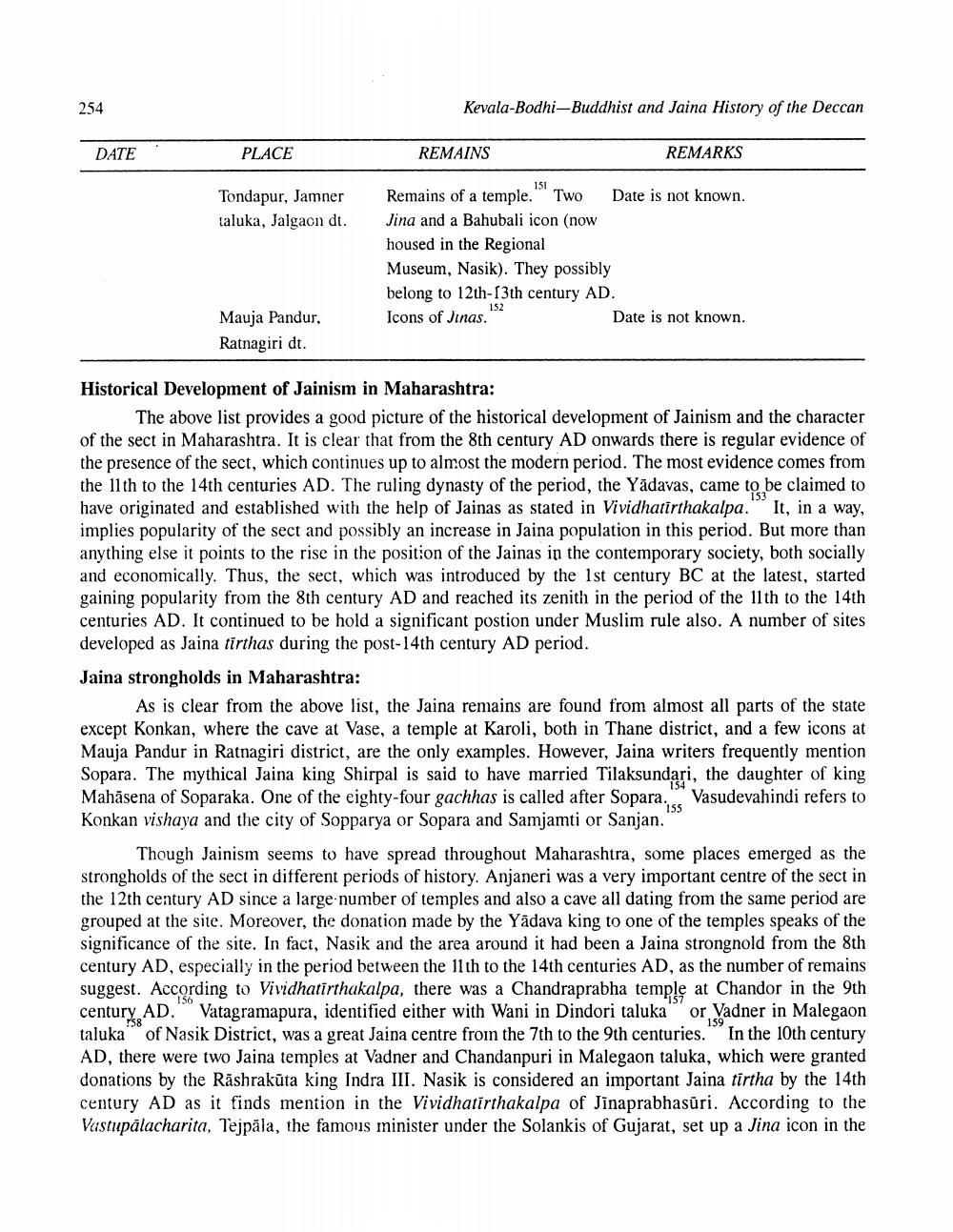________________
254
Kevala-Bodhi-Buddhist and Jaina History of the Deccan
DATE
PLACE
REMAINS
REMARKS
Tondapur, Jamner taluka, Jalgaon dt.
Remains of a temple.""'Two Date is not known. Jina and a Bahubali icon (now housed in the Regional Museum, Nasik). They possibly belong to 12th-13th century AD. Icons of Jinas.
Date is not known.
Mauja Pandur, Ratnagiri dt.
Historical Development of Jainism in Maharashtra:
The above list provides a good picture of the historical development of Jainism and the character of the sect in Maharashtra. It is clear that from the 8th century AD onwards there is regular evidence of the presence of the sect, which continues up to almost the modern period. The most evidence comes from the 11th to the 14th centuries AD. The ruling dynasty of the period, the Yādavas, came to be claimed to have originated and established with the help of Jainas as stated in Vividhatirthakalpa. It, in a way, implies popularity of the sect and possibly an increase in Jaina population in this period. But more than anything else it points to the rise in the position of the Jainas in the contemporary society, both socially and economically. Thus, the sect, which was introduced by the 1st century BC at the latest, started gaining popularity from the 8th century AD and reached its zenith in the period of the 11th to the 14th centuries AD. It continued to be hold a significant postion under Muslim rule also. A number of sites developed as Jaina tirthas during the post-14th century AD period. Jaina strongholds in Maharashtra:
As is clear from the above list, the Jaina remains are found from almost all parts of the state except Konkan, where the cave at Vase, a temple at Karoli, both in Thane district, and a few icons at Mauja Pandur in Ratnagiri district, are the only examples. However, Jaina writers frequently mention Sopara. The mythical Jaina king Shirpal is said to have married Tilaksundari, the daughter of king Mahāsena of Soparaka. One of the eighty-four gachhas is called after Sopara... Vasudevahindi refers to Konkan vishaya and the city of Sopparya or Sopara and Samjamti or Sanjan."
Though Jainism seems to have spread throughout Maharashtra, some places emerged as the strongholds of the sect in different periods of history. Anjaneri was a very important centre of the sect in the 12th century AD since a large number of temples and also a cave all dating from the same period are grouped at the site. Moreover, the donation made by the Yādava king to one of the temples speaks of the significance of the site. In fact, Nasik and the area around it had been a Jaina strongnold from the 8th century AD, especially in the period between the 11th to the 14th centuries AD, as the number of remains suggest. According to Vividhatirthakalpa, there was a Chandraprabha temple at Chandor in the 9th century AD. Vatagramapura, identified either with Wani in Dindori taluka or Vadner in Malegaon taluka of Nasik District, was a great Jaina centre froin the 7th to the 9th centuries. In the 10th century AD, there were two Jaina temples at Vadner and Chandanpuri in Malegaon taluka, which were granted donations by the Răshrakūta king Indra III. Nasik is considered an important Jaina tirtha by the 14th century AD as it finds mention in the Vividhatirthakalpa of Jinaprabhasūri. According to the Vastupālacharita, Tejpāla, the famous minister under the Solankis of Gujarat, set up a Jina icon in the




